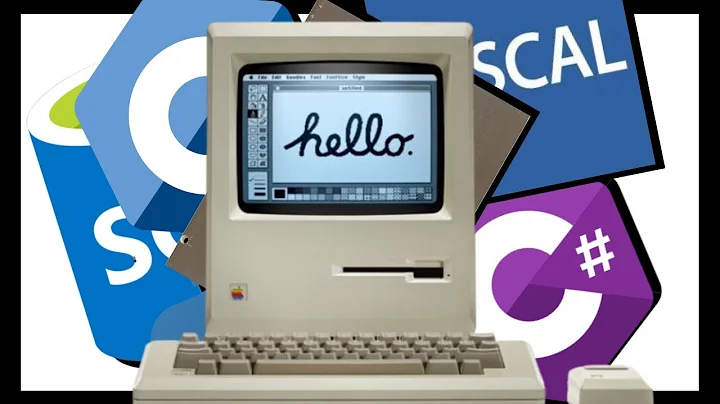How was the first computer program created?
Solution 1
The short answer: the first programs were meticulously written in raw machine code, and everything was built up from there.
The idea is called bootstrapping. Suppose that you have a bare machine with a processor, some flash memory, and a hard disk. Typically, the processor is configured on power-up to load a simple operating system called the bootloader from a fixed location in non-volatile memory (for example, CMOS or flash). This OS is extraordinarily simple and has just enough functionality to point the computer to the spot on disk where the real OS lives. This OS can then turn on more and more devices and load more and more complicated programs, until eventually the whole OS is up and running.
But what is this bootloader written in? Originally, these were written in raw machine code and hardcoded into the machine. The programs it would run would be written in machine code as well, which would be unbelievably slow and tedious to work with. Eventually, someone wrote the first simple assembler in machine code. Once you have this assembler, you can start writing programs in assembly, including the assembler itself. In fact, once you have a simple assembler, you never need to write machine code again. You can just keep writing the assembler in assembly!
From this point you can build more complex programming languages by first writing the compiler using existing tools (the assembler, for example) to get just enough functionality available so that the compiler can do basic programming. You then use that compiler to write a compiler for the programming language itself, and use the same trick to build off of your previous work to get something bigger and cooler. This technique is still used today - most compilers are written in the language they compile to.
To summarize, everything had to be done by hand at some awful point in the past, but thanks to the hard work of the people who did this we can build off of what's already there.
Solution 2
In the early days of the microcomputer industry, we had to laboriously enter machine code directly using toggle switches. This was very similar to the way the first non-hardcoded-program computers were done.
See here for details on the early Altair machines. Basically, you set the binary switches for the address and data then used a command switch to write that to memory. Yes, one byte at a time. We were "real men" back then :-)
From that same site is the detailed process used to enter a sample program.
You should also keep in mind that you don't have to compile programs for machine X actually on machine X. Once machines reached a certain level of sophistication (where, for example, machine Y could run without toggling in programs), you could use cross-assemblers and cross-compilers to actually create the machine language for machine X.
Then you just needed a way to get the binary image of that program into machine X. It wasn't always easy but it was a darn sight easier than toggling switches.
Related videos on Youtube
Peter Cordes
GNU/Linux hacker and command line junkie. Primary maintainer of the Stackoverflow x86 tag wiki. I like efficient code, and knowing how things really work. I mostly use C/C++ (and perl/bash) on Linux, but I mostly look at assembly-language stuff on SO because it's more interesting to me, and there are fewer people posting good asm answers. (profile pic is from https://xkcd.com/386/, and describes me perfectly. Incomplete answers/explanations make me crazy.)
Updated on July 09, 2022Comments
-
 Peter Cordes almost 2 years
Peter Cordes almost 2 yearsPossible Duplicate:
How was the first compiler written?This question has always been bothering me. To compile a program, you need a compiler, which is also a type of program, so what compiled the compiler? Somebody told me that the first compilers were written in assembly or machine code. But thinking about that, that is still not the complete story. After all, how does the machine code go from the hard drive to RAM to the CPU without an operating system and drivers? The drivers had to have been programmed somehow.
I know that the very early computers had switches and allowed you to flip the switch to indicate bits. I am wondering how the leap was made from switches to a way to get the CPU to read machine code without needing a computer program to tell it to do so.
-
Windows programmer about 12 yearsAnyone who ever used front panel switches to input a program on a computer that didn't have a hard disk or compiler knows that this question is not an exact duplicate of questions about compilers.
-
-
user541686 over 13 years"written in raw machine code"? Using what? A text editor? A magnetized needle writing on a disk? That part is a bit vague...
-
user541686 over 13 yearsThe last sentence is true but quite disappointing for an answer IMHO...
-
Windows programmer about 12 yearsRaw machine code was written with pen and paper. Pencil and paper might be considered better, but erasers cost more than scratching out mistakes and rewriting them. Front panel switches were flipped as necessary to enter bits (bytes) into memory. Eventually someone took a journalist's teletype machine and connected it to a computer, so streams of bytes could be saved on paper tape and read back in again later. Someone else took a data warehouse's punched card machines and connected them to a computer. Someone else did the same with magnetic tapes. Disk drives came later.
-
HartleySan about 2 years...Or watch some YouTube videos for free on the subject, and save yourself a lot of time, headaches and money. I'd search for something like "How were the first computers programmed?" for some great videos on the subject.







